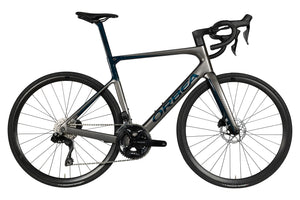How do I choose a rear derailleur for a road bike ?
In this Article
Published on 14 March 2024
The choice of the rear derailleur is crucial for optimizing performance and the pleasure of cycling. Whether you're a casual cyclist, an enthusiast, or a road bike competitor, selecting the appropriate derailleur can make all the difference. Indeed, each cycling discipline, whether leisure-oriented, competitive, or adventurous, requires specific characteristics for the rear derailleur to meet the requirements of each practice. In this regard, it is essential to understand how this mechanism works, the different criteria to consider when choosing this component, whether it's reliability, gear change precision, robustness, or compatibility with the transmission type and riding style. This article will help you understand how to choose the right rear bike derailleur according to your needs.

Rear derailleur: understanding its operation
The rear derailleur fulfills two main functions: changing gears and keeping the chain under tension. When the lever is actuated, the cable moves, causing the derailleur to move, allowing the chain to shift onto another sprocket. A spring maintains chain tension, regardless of the size of the sprocket used.
The rear derailleur, an essential element of a geared bike, consists of several elements:

- The cage: this is the part of the derailleur that supports the tension and guide pulleys of the chain.
- The tension and guide pulleys: they are mounted on the cage and serve to maintain chain tension and guide it during gear changes.
- The adjustment barrel: it allows you to increase or decrease cable tension.
- The mounting bracket: this is the part of the derailleur that attaches to the bike frame using a screw or bolt. It is usually designed to be interchangeable to facilitate derailleur replacement if necessary.
- The tension springs: located inside the derailleur, they serve to maintain chain tension, ensuring smooth and precise gear changes.
- The limit screws that allow you to define the derailleur's range of motion
These elements work together to ensure efficient and smooth gear changes, allowing the cyclist to easily adapt to different terrains and riding conditions.
How to choose a rear derailleur: criteria to consider
The brand
Make sure the derailleur you choose is compatible with your bike's transmission groupset. The brands you will most often encounter are Shimano, SRAM, or Campagnolo. As not all are compatible, avoid mixing brands within the same transmission such as a SRAM derailleur with a Shimano shifter and vice versa. Furthermore, small components such as pulleys should always match the original pulleys.
Number of speeds
It is important that the rear derailleur always matches the number of gears on your cassette. For example, use a 7-speed derailleur with a 7-speed cassette. Do not install a 9-speed derailleur with a 7-speed cassette because the indexing would not work. You can find out the number of speeds by counting the number of sprockets on your cassette or simply by searching by its reference.
Short, medium, or long cage?
Dérailleurs are available in three versions: short, medium, and long cages.
- The short cage derailleur is lighter and less susceptible to impacts. Responsive and durable, it is mainly found on downhill bikes. It offers lower chain tension, allowing for faster and more precise gear changes. It is perfect for performance-oriented cyclists and racing.
- The medium cage is generally suitable for bikes equipped with double chainrings. In the context of sportive use, whether on a road bike or a mountain bike, the goal is to achieve minimal weight and maximum robustness. Therefore, one aims to install as small a cage as possible depending on its use.
- The long cage: it is designed for double chainring transmissions. It offers greater chain capacity, allowing for smooth gear changes even with significant sprocket gaps. It is ideal for cyclists practicing touring, endurance, or gravel as it will allow you to install cassettes with large tooth counts.
To determine the capacity of the derailleur compatible with your bike's gearing, take the maximum cassette sprocket - the minimum cassette sprocket + the maximum chainring sprocket - the minimum chainring sprocket.
Which derailleur to choose for a road bike?
Range type
To make things clearer, here are the usual models you can find, from entry-level to high-end at Shimano, Sram, and Campagnolo:
|
SHIMANO |
SRAM |
CAMPAGNOLO |
|
|
Entry-level |
|
|
|
|
Mid-range |
|
|
|
|
High-end |
|
|
|
|
High-end + |
|
|
|
Level of Practice
The choice of the rear derailleur for your bike will mainly depend on your activity, whether it's sports or leisure, as well as the type of terrain you will encounter. Indeed, the number of chainrings and the speed range of your bike depend directly on it. It is important to note that currently, most road bikes are equipped with transmissions of 9, 10, 11, or even 12 speeds. Moreover, manufacturers like Campagnolo, Shimano, and SRAM each offer rear derailleurs adapted to this discipline. The upgrade in range will mainly depend on your practice and the bike you have. For sustained practice, for example, you will be advised more towards SRAM Force or Rival, or Ultegra vs Shimano 105.
Budget
Once again, there's no need to invest in a high-end transmission if your bike doesn't justify it. It would be a shame; the cost of maintenance and parts replacement will be considerably higher, and, most importantly, you won't see the benefit.
To better identify your needs, let's focus on the leader Shimano:
|
SHIMANO |
For whom? |
Our opinion |
|
Sora |
For those who are starting in road cycling without wanting to invest a considerable amount. |
It stands out for its robustness and reliability. |
|
Tiagra |
It is an ideal choice for starting in cycling at a lower cost. However, it should be noted that it is limited to a maximum of 10 speeds. |
Although slightly heavier than Shimano 105, it is an excellent compromise between price and performance. |
|
105 |
It is suitable for all cyclists who want to have fun. |
THE reference for road bikes. It also stands out as the cheapest groupset available in 11 speeds. It is now available in Di2 version. It benefits from exceptional quality-price-reliability ratio. |
|
Ultegra |
For those seeking even more performance, especially cyclists who practice competition |
It is widely adopted in the world of competition. It stands out for its extreme reliability, precision, durability, and considerably lighter weight than the 105. Moreover, an electronic version, the Ultegra Di2, is also available for those seeking even more performance. |
|
Dura-Ace |
For professional cyclists and competitors |
It stands out for its extremely reduced weight. However, this lightness comes at the expense of durability, making it a less suitable choice for frequent use and varied weather conditions. It is available in an electronic version for those seeking ultimate performance. |
For your information, while SRAM and Shimano are in the same price ranges, Campagnolo remains significantly more expensive.
👉 Are you hesitating between SRAM vs Shimano transmission: which model to choose?
Mechanical vs Electronic
Although high-end mechanical derailleur provides an exceptional experience, the electronic version is not to be outdone. It allows for much faster and more precise gear shifting while being very silent. Market leaders have therefore opted for the "electric" transmission for some high-end and intermediate models such as Campagnolo (EPS), Sram Eagle AXS, Ultegra, Dura-Ace, and Shimano 105 (Di2).
👉 If you're torn between electric vs mechanical transmission, we've written a comprehensive article on this topic.
Durability
In terms of durability, the mechanical derailleur has nothing more to prove. We still find bikes with a derailleur over fifty years old. Let's say for the electric derailleur, it's a bit shorter. Its integrated battery has a lifespan closer to 8 years, sometimes less, depending on whether it is subjected to many shocks and vibrations.
How to adjust a rear derailleur?
A properly adjusted derailleur is essential to avoid chain skips, derailments, and other undesirable noises.
Here's how to adjust your new rear derailleur step by step:
- Visually check the alignment of the derailleur hanger. If it appears to be bent, straighten it or have a bike technician do this for you.
- Adjust the stops to avoid derailment. Start with the low one and then the high one.
- Adjust the angle of the derailleur. The closer the pulley is to the cassette, the more precisely your gears will shift.
- Adjust the cable tension.
In the video, our mechanic explains the precise steps:
To make your task easier, and to ensure that the rear wheel rotates freely, use a bike stand. It's also part of our list of the most beautiful gifts to give to a cyclist. 😉
However, don't panic, if you're not comfortable and familiar with adjusting the rear derailleur or front one, trust your favorite bike shop.
In summary, choosing the model of rear derailleur, whether it's an electronic or mechanical version, will depend on your needs, your budget, but also on the two-wheeler you have. If you want to get the ideal bike that meets all your criteria, but is also reconditioned by a professional mechanic and comes with a one-year warranty on the frame and components, trust The Cyclist House.

































